新八下英语教案Unit4
- 格式:docx
- 大小:23.70 KB
- 文档页数:18
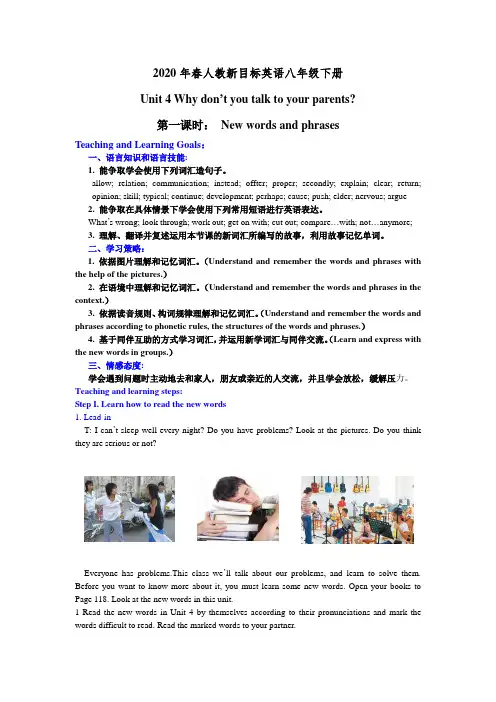
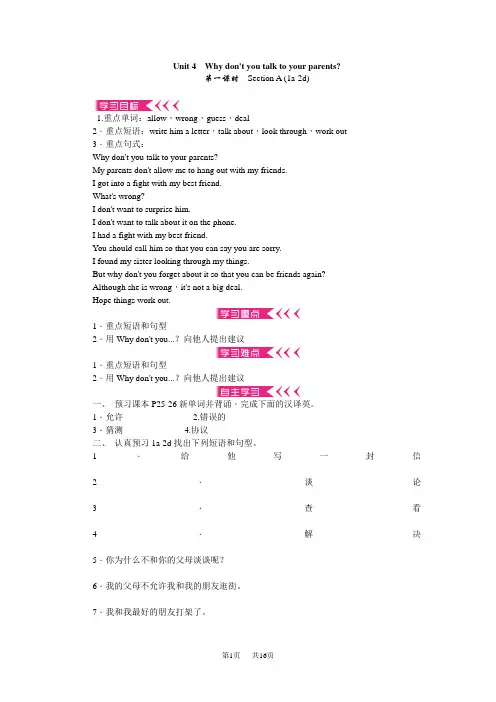
Unit 4Why don't you talk to your parents?第一课时Section A (1a-2d)1.重点单词:allow,wrong,guess,deal2.重点短语:write him a letter,talk about,look through,work out3.重点句式:Why don't you talk to your parents?My parents don't allow me to hang out with my friends.I got into a fight with my best friend.What's wrong?I don't want to surprise him.I don't want to talk about it on the phone.I had a fight with my best friend.You should call him so that you can say you are sorry.I found my sister looking through my things.But why don't you forget about it so that you can be friends again?Although she is wrong,it's not a big deal.Hope things work out.1.重点短语和句型2.用Why don't you...?向他人提出建议1.重点短语和句型2.用Why don't you...?向他人提出建议一、预习课本P25-26新单词并背诵,完成下面的汉译英。
1.允许____________ 2.错误的____________3.猜测____________ 4.协议____________二、认真预习1a-2d找出下列短语和句型。

Unit 4Why don’t you talk to your parents?1. Talk about the problems.2. Learn the new language points.1. The differences of“cut up , cut off, cut out”.2. The usage of“compare. . . with. . . ”.现如今父母与青春期孩子们之间的矛盾越来越多, 有的孩子经常对父母发火, 甚至几天不说话。
请以“How to get along well with parents”为题, 阐述父母与孩子间产生矛盾的原因, 以及改善关系的解决措施。
词数: 100词左右。
要点可以包括:1)产生矛盾原因: 父母过分关注分数; . . .2)改善关系的措施: 多交流; . . .How to get along well with parentsNowadays, more and more teenagers can’t get along well with their parents. They often get mad at their parents and some of them even don’t talk with their parents for several days. Why does the relationship between teenagers and parents get so bad? Here are some reasons.First, much attention is paid to teenagers’ grades in exams by parents. They only want to see their kids studying all the time without having a rest or having their own time. Second, both teenagers andparents don’t spend much time in communicating with each other. Parents are always busy with their work. They even don’t understand each other.How to make the relationship better? The followings are the ways to solve this problem. First of all, parents are supposed to spend more time with their f amily. It’s important to take some time to communicate if there are some problems. Besides, both parents and teenagers should find a right way to express their love and talk about their own thoughts to each other. All the problems can be solved by love and understanding.I hope the relationship between parents and teenagers can be good at any time. If both of them would like to spend time and efforts in how to solve the problems between them, they will have a happy and wonderful life together.本课时从一开始即给了学生明确的教学任务, 达到开门见山的效果, 让学生学习的目标性更强, 小组练习的方式也能加强学生对知识点的巩固。
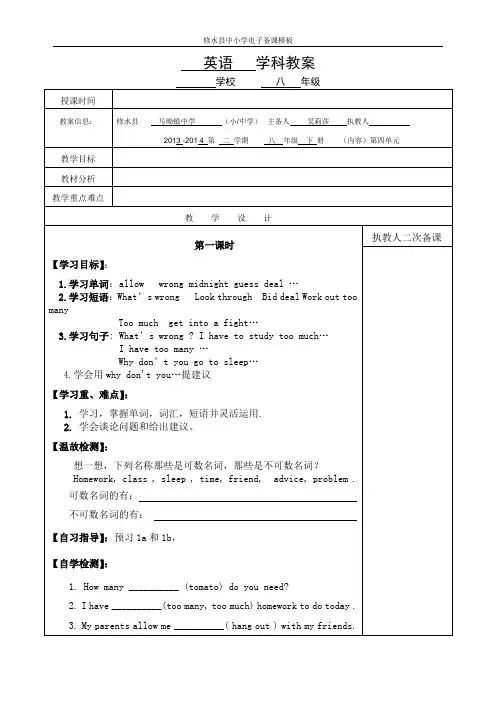
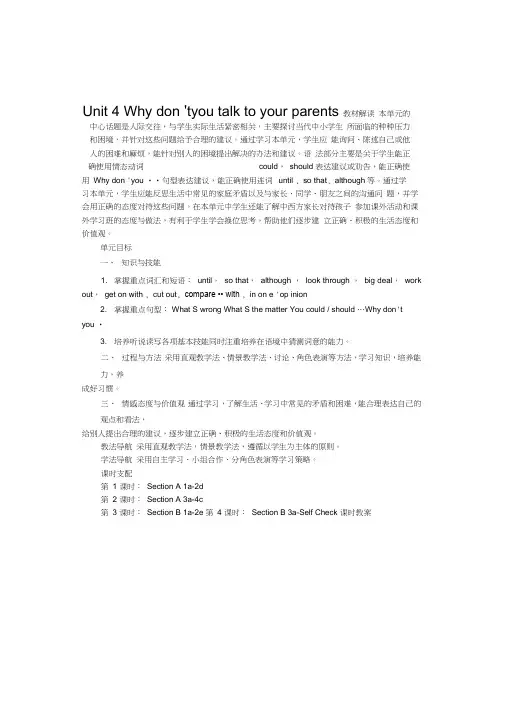
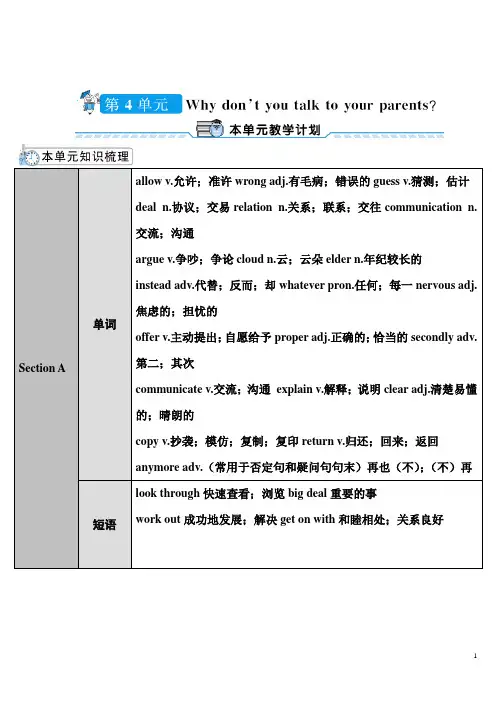
Section A 单词allow v.允许;准许wrong adj.有毛病;错误的guess v.猜测;估计deal n.协议;交易relation n.关系;联系;交往communication n.交流;沟通argue v.争吵;争论cloud n.云;云朵elder n.年纪较长的instead adv.代替;反而;却whatever pron.任何;每一nervous adj.焦虑的;担忧的offer v.主动提出;自愿给予proper adj.正确的;恰当的secondly adv.第二;其次communicate v.交流;沟通explain v.解释;说明clear adj.清楚易懂的;晴朗的copy v.抄袭;模仿;复制;复印return v.归还;回来;返回anymore adv.(常用于否定句和疑问句句末)再也(不);(不)再短语look through快速查看;浏览big deal重要的事work out成功地发展;解决get on with和睦相处;关系良好句型1.Many of them are learning exam skills so that they can get into a good high school and later a good university.他们中很多人正在学习应试技巧以便能考入一所好高中,进而升入一所好大学。
2.The Taylors are a typical American family.泰勒家就是一个典型的美国家庭。
3.And they are always comparing them with other children.而且她们总是将自己的孩子和别的孩子相比较。
语法although, so that及until引导的状语从句知识目标掌握课文中的重点词汇及相关短语,并灵活运用。
能力目标学会谈论问题和给出建议情感目标遇到问题要主动地去和家人、朋友或亲近的人交流;如果身边的人遇到问题,能主动提供帮助;要学会放松、缓解压力。
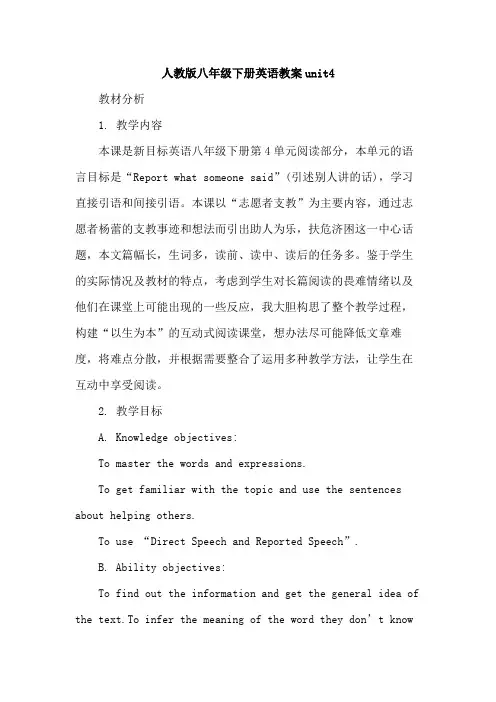
人教版八年级下册英语教案unit4教材分析1. 教学内容本课是新目标英语八年级下册第4单元阅读部分,本单元的语言目标是“Report what someone said”(引述别人讲的话),学习直接引语和间接引语。
本课以“志愿者支教”为主要内容,通过志愿者杨蕾的支教事迹和想法而引出助人为乐,扶危济困这一中心话题,本文篇幅长,生词多,读前、读中、读后的任务多。
鉴于学生的实际情况及教材的特点,考虑到学生对长篇阅读的畏难情绪以及他们在课堂上可能出现的一些反应,我大胆构思了整个教学过程,构建“以生为本”的互动式阅读课堂,想办法尽可能降低文章难度,将难点分散,并根据需要整合了运用多种教学方法,让学生在互动中享受阅读。
2. 教学目标A. Knowledge objectives:To master the words and expressions.To get familiar with the topic and use the sentences about helping others.To use “Direct Speech and Reported Speech”.B. Ability objectives:To find out the information and get the general idea of th e text.To infer the meaning of the word they don’t knowfrom the context.C. Affective objectives:Students are to realize the importance of helping others and they are encouraged to help others.Students’ team spirit will be improved by completing a certain task together.By understanding the life in rural areas, students are to realize how happy they are.3. 教学策略:(1)兴趣激发策略。

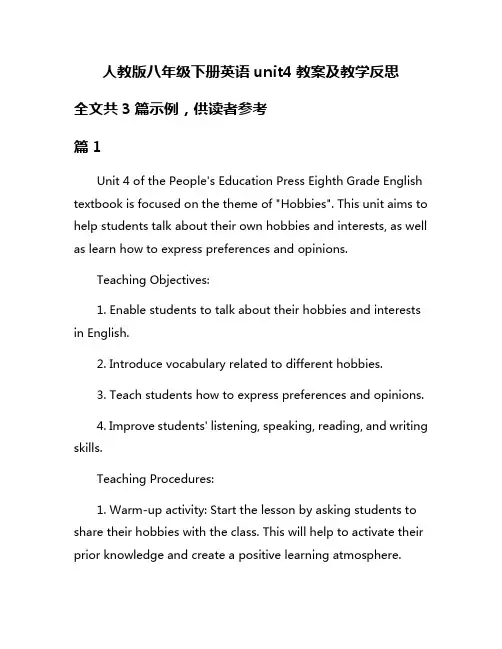
人教版八年级下册英语unit4教案及教学反思全文共3篇示例,供读者参考篇1Unit 4 of the People's Education Press Eighth Grade English textbook is focused on the theme of "Hobbies". This unit aims to help students talk about their own hobbies and interests, as well as learn how to express preferences and opinions.Teaching Objectives:1. Enable students to talk about their hobbies and interests in English.2. Introduce vocabulary related to different hobbies.3. Teach students how to express preferences and opinions.4. Improve students' listening, speaking, reading, and writing skills.Teaching Procedures:1. Warm-up activity: Start the lesson by asking students to share their hobbies with the class. This will help to activate their prior knowledge and create a positive learning atmosphere.2. Vocabulary introduction: Introduce key vocabulary related to hobbies, such as "painting", "cooking", "playing sports", etc. Use pictures, gestures, and realia to help students understand and remember the new words.3. Listening comprehension: Play a listening passage where people talk about their hobbies. Students listen and then answer comprehension questions to check their understanding.4. Speaking practice: Divide the class into pairs or groups and ask them to discuss their own hobbies, using the vocabulary they have learned. Encourage students to ask questions and share their opinions with each other.5. Reading activity: Give students a reading passage about different hobbies and ask them to identify key information, such as the benefits of each hobby and how to get started.6. Writing task: Ask students to write a short paragraph about their favorite hobby, describing why they enjoy it and how it makes them feel. Provide feedback on their writing to help improve their language skills.7. Role-play activity: Divide students into pairs and give them a role-play scenario where they discuss their preferencesfor different hobbies. This will help them practice expressing opinions and using the target vocabulary.8. Review and assessment: End the lesson with a review of key vocabulary and concepts covered in the unit. Administer a quiz or speaking activity to assess students' understanding and progress.Teaching Reflection:Overall, teaching Unit 4 on Hobbies was engaging and effective. The activities helped students practice speaking, listening, reading, and writing skills in a fun and interactive way. However, one area for improvement is to provide more opportunities for students to use the target language in real-life contexts. For example, incorporating project-based learning tasks where students create a hobby-themed presentation or video could further enhance their language proficiency.In conclusion, Unit 4 provided a valuable opportunity for students to explore their interests and hobbies in English. By incorporating a variety of activities and assessments, teachers can help students achieve the learning objectives and improve their English language skills.篇2Unit 4 of the People's Education Edition eighth grade English textbook covers the topic of "Wild Animals". In this unit, students will learn vocabulary related to wild animals, practice reading and listening skills through various texts, and improve their ability to describe animals and discuss their habitats.Lesson 1:- Warm-up: Start the lesson by asking students to name different wild animals they know.- Vocabulary: Introduce new vocabulary words related to wild animals such as lion, elephant, tiger, etc.- Reading: Read a short passage about different wild animals and ask students comprehension questions.- Listening: Play a recording of different animal sounds and ask students to match the sound with the correct animal.- Speaking: Have students describe their favorite wild animal and why they like it.Lesson 2:- Warm-up: Review the vocabulary words from the previous lesson by playing a matching game.- Reading: Read a longer passage about a safari trip and ask students to identify the animals mentioned in the text.- Grammar: Introduce comparatives and superlatives using examples related to wild animals (e.g. The elephant is bigger than the giraffe).- Speaking: Have students work in pairs to discuss which animal they think is the most interesting and why.Lesson 3:- Warm-up: Play a game of charades where students act out different wild animals for their classmates to guess.- Reading: Read a passage about endangered animals and discuss why it is important to protect them.- Writing: Have students write a short paragraph about what they can do to help protect endangered animals.- Speaking: Conduct a class debate on whether or not zoos are good for wild animals.Lesson 4:- Warm-up: Review the vocabulary and grammar concepts learned in the previous lessons through a quiz.- Project: Have students work in groups to create a poster about a specific wild animal, including information about its habitat, diet, and interesting facts.- Presentation: Have each group present their poster to the class and answer questions from their classmates.Teaching Reflection:Overall, the unit was engaging and interactive for students. The variety of activities helped to keep students interested and motivated throughout the lessons. The vocabulary and grammar concepts were presented in a clear and concise manner, allowing students to grasp the new material easily. The project at the end of the unit provided students with an opportunity to apply what they had learned and showcase their creativity. However, I would like to incorporate more opportunities for students to practice speaking and listening skills in future lessons to further develop their language proficiency.篇3Unit 4 of the eighth-grade textbook by People's Education Press focuses on the theme of "Wild animals". In this unit, students will learn about various wild animals and their habitats, as well as the importance of wildlife conservation.The unit is divided into several sections, including reading, listening, speaking, and writing tasks. The reading passages describe different wild animals such as lions, elephants, and pandas, providing students with essential information about these creatures. The listening activities help students improve their listening skills by practicing comprehension and understanding spoken English. Speaking tasks encourage students to express their opinions and share information about wild animals with their peers. Writing tasks require students to write short paragraphs or essays about their favorite kind of wild animal or the importance of wildlife conservation.To begin the unit, teachers can introduce the topic of wild animals by showing pictures or videos of different types of wildlife. This can generate interest and curiosity among students, prompting them to learn more about these fascinating creatures. Teachers can also engage students in group discussions or debates about wildlife conservation and the impact of human activities on the environment.During the reading and listening activities, teachers should provide support and guidance to students as they work through the text and audio materials. Encouraging students to ask questions, make predictions, and summarize key points can helpthem better comprehend the information presented. Teachers can also incorporate vocabulary-building exercises, such as word matching or crossword puzzles, to reinforce new words and concepts.For the speaking and writing tasks, teachers can encourage students to use creative expression and critical thinking skills. Providing opportunities for role-playing, storytelling, and collaborative writing can enhance students' language abilities and boost their confidence in using English. Teachers can also assign group projects or presentations that require students to research and present information about specific wild animals or conservation efforts.In conclusion, Unit 4 of the eighth-grade textbook by People's Education Press offers a comprehensive and engaging exploration of wild animals and wildlife conservation. By incorporating a variety of teaching strategies and activities, teachers can facilitate students' learning and language development in a meaningful and enjoyable way. Through active participation and interaction, students can deepen their understanding of the natural world and cultivate a sense of responsibility towards protecting our environment and its inhabitants.。
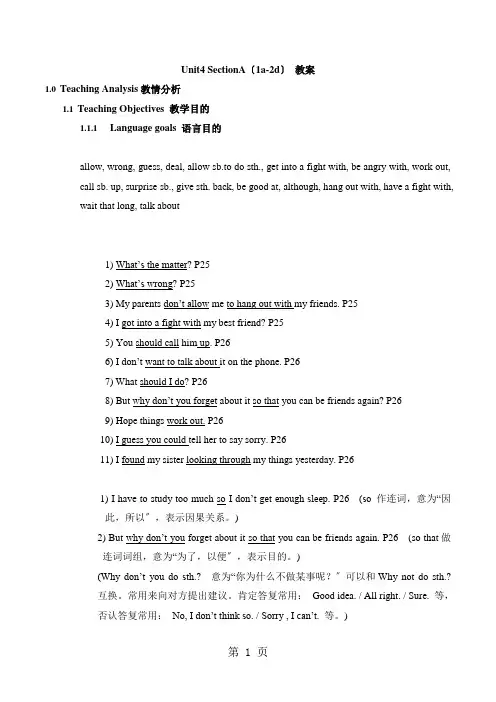
Unit4 SectionA〔1a-2d〕教案1.0Teaching Analysis教情分析1.1Teaching Objectives 教学目的1.1.1Language goals 语言目的allow, wrong, guess, deal, allow sb.to do sth., get into a fight with, be angry with, work out, call sb. up, surprise sb., give sth. back, be good at, although, hang out with, have a fight with, wait that long, talk about1) What’s the matter? P252) What’s wrong? P253) My parents don’t allow me to hang out with my friends. P254) I got into a fight with my best friend? P255) You should call him up. P266) I don’t want to talk about it on the phone. P267) What should I do? P268) But why don’t you forget about it so that you can be friends again? P269) Hope things work out. P2610) I guess you could tell her to say sorry. P2611) I found my sister looking through my things yesterday. P261) I have to study too much so I don’t get enough sleep. P26 (so 作连词,意为“因此,所以〞,表示因果关系。
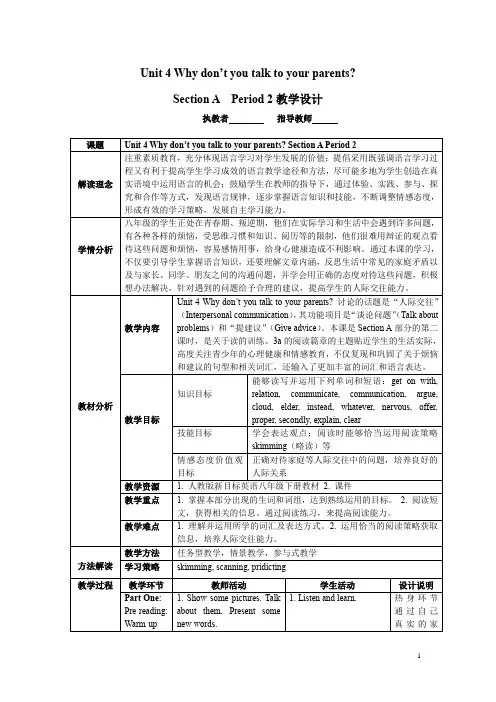
Unit 4 Why don’t you talk to your parents?Section A Period 2教学设计执教者指导教师学情分析从生理学和心理学的角度分析,八年级的学生正处在青春期、叛逆期,他们在实际学习和生活中会遇到许多问题,有各种各样的烦恼,受思维习惯和知识、阅历等的限制,他们很难用辩证的观点看待这些问题和烦恼,容易感情用事,给身心健康造成不利影响。
通过本课的学习,不仅要引导学生掌握语言知识,还要理解文章内涵,反思生活中常见的家庭矛盾以及与家长、同学、朋友之间的沟通问题,并学会用正确的态度对待这些问题,并积极想办法解决,而不是消极地逃避问题,针对遇到的问题给予合理的建议,使学生形成乐观、宽容、大度、慷慨的个性,促进学生的身心健康成长,提高学生的人际交往能力。
从教学的角度分析,要注意将中心话题与学生实际生活密切地联系起来,创设人际关系问题情境,让学生参与其中,激发学生的学习兴趣,培养良好的教学氛围,对学生的听说读写能力进行全方位的训练和提升,让学生将学和用紧密地结合起来,从而提高综合语言运用能力。
效果分析本课是阅读教学,能从教学内容和学生已有知识经验出发,构建“教师启动,学生主动,师生互动”的阅读模式,重视阅读过程, 把阅读分为阅读前、阅读中和阅读后三个阶段,密切联系学生的学习生活实际,通过多种互动形式如Summary,Discussion,Suevey and report 等让学生动起来,为学生体验、参与、实践与合作学习提供了充分的机会,活动的设计从学生实际生活经验出发,层层递进,激发了学生兴趣,调动了学生学习的积极性,发展了学生的综合语言运用能力,使学生积极参与到获取信息和处理信息的过程中,实现了语言学习与语言运用的有机结合。
在传授语言知识,培养语言技能的同时,充分挖掘文本中的思想内涵,有机渗透品德教育,使学生的情感态度价值观实现升华。
由于课文中的生词和短语较多,这给学生的顺利阅读带来了很大困难,尽管在热身环节运用图片等,形象直观地做了解释说明,但在一节课里让学生熟练掌握和运用还是非常不容易的,因此在语言输出环节可能出现学生不会读、不会说、不会用的问题。
Step 5:Listening活动一、出示听力图片引导学生猜测“Is she happy? What ’s wrong with the girl?” 播放录音 并根据学生完成听力情况调整听力次数 看图片做听力猜测,读1a 句子做好听力准备,核对答案。
活动二、fill in the blanks再次听力,补全朋友给出的建议。
重视听力策略的训练 活动二的设计一方面是根据学生的水平对听力材料难度进行的调整,另一方面也是为了让学生继续感知问题与建议这一话题。
Step 6:Group work If your classmates have some troubles, can you giv e them some advice? Try to give advice in groups. 并进行总结给出建议的几种方式。
小组合作讨论问题并给出恰当的建议,利用小组的作用,调动学生的积极性。
Step 7 :pair work T : There is something wrong with me . can you give me advice?T: Now it ’s your turn. Work in pairs to makea new conversation从师生对话过渡到生生对话,进行目标语言的操练。
Step8: ListeningShow the picture lead in the listening 2a 、2b Look at the picture and guess “What ’s the matter with Peter?”Read the advice that Peter ’s friend gives himand the reason why Peter doesn ’t like theadviceDo listening and Check the answers.通过导入听前活动,做好听力准备,进行听力训练。
Unit 4 Why don’t you talk to your parents课题Section B 1 (1a-2e)课型新授课教学目标1. 语言知识目标:1) 能掌握以下单词:member, pressure, compete, opinion, skill, typical, football, cut out, continue, compare, compare…with, crazy, push, de velopment, cause, usual2) 能掌握以下句型:① I think Wei Ming should…② Although you may be…, you should talk to them.③ Life shouldn’t just be about …④ Why don’t they just let their kids be kids?⑤ Al though it’s normal to want successful children, it’s even more important to ha ve happy children.2. 情感态度价值观目标:了解中国及一些其他国家中学生们普通存在的生活及学习上问题,了解别人的生活现状及他们苦恼,知道学习知识是很重要的事情,但它并不是生活的全部。
重点 1) 掌握本课时出现的生词及用法。
2) 进行听力训练,提高综合听说能力。
3) 阅读短文,获得相关信息,提高学生们的综合阅读能力。
难点1. 听力训练2. 阅读2b部分的短文并完成相关要求。
教学用具多媒体教学环节说明二次备课复习新课导入课程讲授Step 1 Revision1. Daily greeting.2. 复习提建议的表达方式,并完成相关任务。
3. Check the homework. Let some Ss give advice.Step 2 Warming up1. T: Show a picture of student.—What’s wrong with the girl?—She’s too stressed out.—What should she do? Can you give her some advice?2. Ss discuss the problem and give some advices:e.g.S1: Why not hang out with her friends.S2: She could play sports.S3: She could play computer games.S4: She should listen t o music and read some books.Step 3 WritingWork on 1b1. Ask one student read the sentences in 1a. Explain some main sentences.2. What activities do you like to help lower your stress? Orderthem from 1-8 with being the most favorite thing you do to lower stress.3. Ss discuss with their desk mates then order them.4. Let some Ss say their answersStep 4 TalkingLet some Ss talk about their answers.S1: I always hang out with my friends to lower stress.S2: I like to listen to music to lower stress best.Step 5 ListeningWork on 1c:1. Tell Ss to read the sentences 1c first.2. Play the recording for the Ss. Ss just listen for the first time. Play the recording again and check the problems Wei Ming talks about.3. Check the answers:Work on 1d:1. Let Ss read the sentences in 1d first. Tell Ss to listen again and fill in the blanks.2. Play the recording again for the Ss to listen and write.3. Ss listen to the recording carefully and try to write the words in the blan ks.4. Check the answers with the class.Step 6 Pair work1. Work in pairs. Suppose your partner is Wei Ming. You try totell her some advice and say why.2. Let two students make a model for the Ss.3. Ss practice their conversations4. Teacher can walk around the classroom, and give some help to the Ss.Step 7 Thinking1. T: There are some after-school activities. What activities doyou and your classmates usually do? Check them.2. Ss check the activities they usually do.3. Ask some Ss say their choices.Step 8 ReadingWarming upWhat did you do after school?Do you have stress in your life?How do you relax yourself?Fast Reading1. T: Now let’s work on 2b. First, let’s read the questions andmake sure we know the mea nings of all the questions. Thenread the passage quickly and find the answers to thequestions.1) What is the common problem for Chinese and American families?2) Who gives their opinions about the problems?2. Ss read the letter quickly and try to find the answers to the two questions.3. Check the answers wit h the class.Careful Reading1. T: Now let’s read these sentences about the letter. Read thepassage again. Judge if the sentences are True or False.Please underline under the main sentences.1) Chinese children have to take so many after-school classeson weekends these days.2) Cathy Taylor really wants her three children to besuccessful, so she believes these after-school activitiesare important for them.3) Linda Miller thinks parents should send their small kids toall kinds of classes.4) Linda thinks some parents push their kids too much.5) Alice thinks kids shouldn’t have time to relax and think for themselves2. Ss read the letter again and judge the sentences.3. Check the answers with the class.Post readingWork on 2c1. Now look at the words in bold in the article. Can you guesstheir meanings? Try to match them with the meaning below.2. Let Ss read and try to match the words.3. Give Ss some advice on how to do it.4. Check the answers with the Ss.5. Give some explanation about the difficult words.Work on 2d1. Tell Ss to read the passage again and answer these questionsbelow.1) Does Cathy Taylor think it’s important for kids to join afterschool activities?2) Does Linda Miller agree with Cathy? What’s her opinion?3) Does Dr. Green agree with Cathy or Linda? What does she say?2. Ss work by themselves.3. Check the answers toge ther.小结Summary作业布置Homework1. Read the article again after school.2. Write a short passage about Cath y’s daily life and her opinionsabout the education of the kids.板书设计课后反思Unit 10 I’ve had this bike for three years课题Unit 10 I’ve had this bike for three years. 课型新授课Section A1 (1a-2d)教学目标一、知识与技能1.掌握本课单词和短语:search am ong,crayon,shame,regard…as count,century,according to,opposite,especially,memory,consider,hold2. 能从阅读中获得自己周围的事物变化的相关信息。
Unit4He said I was hard-working.1.Fill in the blanks with the words given.happen bring copy borrow pass on复制抄袭1.Can you some music CDs to the party?2.It’s not right for you to others’homework.3.He didn’t know what was outside.4.I’m so cold.Can I your jacket?5.I’m seeing Sue this afternoon.Do you want meto any messages?2.Read the story and then write it as a conversation.My best friend is Xiao Li,but last week in school we had a big fight,and she didn’t talk to me.It all started when she ask ed me if she could copy my homework.I ask ed her why she wanted to do that,and she said that she had forgotten to do hers.I said I didn’t think it was a good idea for her to copy my homework.She wanted to know why I didn’t think it was a good idea.I said it would start a bad habit,and that she should do her own work.She got really mad at me,and said she didn’t want to be my best friend anymore.I said that was OK and that I was sure she would get over it.And she did.Y esterday she told me she was sorry.She said it was mu ch better if she did her own workhers她的(名词性物主代词)own自己的get over克服;忘掉;原谅Language Points1.I ask ed her why she wanted to do that,and she said that she had forgotten to do hers.我问她为什么要那么做,她说她忘记做作业了。
Unit 4 Why don’t you talk to your parents?第一课时(Section A 1a-1c)【学习目标】1. 学习谈论生活中遇到的问题,会使用could或should来表达建议。
2. 通过谈论生活中遇到的问题及听取别人的建议,合理宣泄不良情绪,学会与他人友好相处。
【学习重点】★重点单词:allow(允许;准许),wrong(有毛病的;错误的).★重点短语:allow sb. to do sth.(允许某人做某事),hang out (闲逛),get into a fight(吵架;打架).★重点句型:—What’s wrong?(怎么了?)—I’m really tired because I studied until midnight last night.(我真的很累,因为我昨天晚上学到半夜。
)—Why don’t you go to sleep earlier this evening?(你为什么今天晚上不早点睡觉呢?)【课前预习方案】(一)小小翻译官。
(请预习课文,将下列中文译成英文)。
1. 不得不做某事have to do sth.2. 得到足够的睡眠get enough sleep3. 太多作业too much homework4. 空闲时间free time5. 允许某人做某事allow sb. to do sth.6. 闲逛hang out7. 课后补习班after-school classes 8. 吵架;打架get into a fight9. 学到半夜study until midnight 10. 早点睡go to sleep earlier(二)请朗读1a中学生遇到的各种烦恼,对你来说这些问题中哪些是严重的,哪些是不严重的?根据你的看法将它们的序号写在方框里。
(三)想一想。
你能想出几种提建议的方法?请把他们写在下列横线上。
1.You could...2.You should...3.What about...?4.How about...?5.Why don’t you...?【课堂活动方案】活动一:学习1a的各种烦恼。
人教版八下英语Unit4全单元教案(经典建议收藏)课时1 教学目标1. 学生能够认读并理解本单元的新词汇和短语。
2. 学生能够听懂并理解有关周末活动的对话。
3. 学生能够用英语描述自己和他人的周末活动。
4. 学生能够根据对话内容完成相关练。
5. 学生能够根据提示写出与周末活动相关的句子。
课时2 教学目标1. 学生能够根据图片和提示对周末活动进行描述。
2. 学生能够听懂并理解有关借和还物品的对话。
3. 学生能够通过对话内容完成相关练。
4. 学生能够根据对话提示写出与物品借还相关的句子。
课时3 教学目标1. 学生能够听懂并理解有关约会的对话。
2. 学生能够运用所学句型和词汇进行对话练。
3. 学生能够根据对话内容完成相关练。
4. 学生能够用英语描述自己的约会经历。
5. 学生能够根据提示写出与约会相关的句子。
课时4 教学目标1. 学生能够听懂并理解有关邀请的对话。
2. 学生能够根据对话内容完成相关练。
3. 学生能够根据提示写出与邀请相关的句子。
课时5 教学目标1. 学生能够听懂并理解一篇有关暑假计划的短文。
2. 学生能够运用所学句型和词汇进行短文理解和书面表达练。
3. 学生能够根据短文内容完成相关练。
4. 学生能够用英语描述自己的暑假计划。
5. 学生能够根据提示写出与暑假计划相关的句子。
课时6 教学目标1. 学生能够运用词汇和句型描述日常生活中的活动。
2. 学生能够运用所学句型和词汇进行对话练。
3. 学生能够根据对话内容完成相关练。
4. 学生能够根据提示写出与日常活动相关的句子。
课时7 教学目标1. 学生能够听懂并理解有关节日庆祝的对话。
2. 学生能够用英语描述自己喜欢的节日。
3. 学生能够运用所学句型和词汇进行对话练。
4. 学生能够根据对话内容完成相关练。
5. 学生能够根据提示写出与节日庆祝相关的句子。
课时8 教学目标1. 学生能够听懂并理解有关健康惯的对话。
2. 学生能够根据对话内容完成相关练。
3. 学生能够用英语描述自己和他人的健康惯。
课题课时Period 1教学目标语言技能听:能听懂他人他人陈述困难和麻烦的简单对话的内容,并获取主要信息。
说:1.能询问、陈述自己或他人的困难和麻烦,如What’s wrong?I’m really tired because I studied until midnight last night.2.能针对别人的困境提出解决的办法和建议,如What should Ido?Well,you should call him so that you can say you’re sorry.语言知识语音:熟练把握邀请句的升调语调,同时,在口语交流时能做到语音、语调准确、自然、流畅。
词汇:1.熟练运用:allow,wrong,midnight,guess,de al.2.掌握:What’s wrong, look through,work out.语法:1.能正确使用情态动词could,should表达或劝告,如:Youcould go to his house.2.能正确使用Why don’t you...?句型表达建议。
功能:学会询问、陈述自己或他人的困难和麻烦。
话题:了解人际交往的相关知识。
情感态度1.培养学生用英语交际能力,学会与人进行流畅的沟通和交流;2.使学生在活动中学会真诚、坦然地与人交谈。
学习策略认知策略:能在具体的情境中询问、陈述自己或他人的困难和麻烦,从而进一步主动练习和实践。
调控策略:.能针对别人的困境提出解决的办法和建议,并与人进行交流。
交际策略:培养学生合作能力,不断完善知识点,加强对话练习,学会与人闲聊,进行交流。
资源策略:通过多媒体、录音机等教学辅助工具。
文化意识了解中西方家长对待孩子参加课外活动和课外学习班的态度与做法。
教学重难点教学重点1.能正确使用情态动词could,should表达或劝告。
2.能正确使用Why don’t you...?句型表达建议。
教学难点1.Talk about problems.2.Give advice.教学方法听说法,交际法,教学辅助手段PPT, recorder.板书设计Unit4 Why don’t you talk to your parents?Sectio n A 1a-2dallow What’s wrong?wrong Why don’t you...?midnightguessdeal教后反思本节课学会了提建议的方式有:Why don’t you...? /Why not…?等Teaching ProcedureStages/TimingStep 1. warming-upStep 2 PresentationStep3 DiscussionStep 4Pre sentationStep 5 ListeningTeach ers’ a ctivitiesAfter greeting, ask students :What day is it today?What’s the date today?What’s the weather like today?1. Show the picture of a girl:T: Please look at this girl,what isshe doing?T: Look at her face,she isworried.because she has a lotof homework to do.Do yo uhave too much homework todo?Do you think it is serious?1a.Get them to read the followingsentences and discuss wheatherthey are serious or not. And thenwrite them in the approprite boxT:Do you have theseproblems?What kind of problemsdo you have?Students’ activitiesStudents answer the questions。
Unit 4 Why don 'tyou talk to your parents?The First PeriodI .Teach ing Aims and Dema nds1. Knowledge Objects(1) Key vocabularyallow; wrong; midnight; What 's wrong?(2) Key structures What'swrong?I'm really tired because I studied until midnight last night.Why don'tyou go to sleep earlier this evening?(3) Listening practicePairwork2. Ability ObjectsTo train listening skill.To train students'ability of communication.3.Sensibility and ValueTo be interested in taking part in all kinds of activities in an English class. n .Teaching Key Point Vocabulary and structures.川.Teaching DifficultiesListening practice.Pairwork.IV.Teaching Methods Listening and speaking methods.Communicative approach.V.Teaching AidsA tape recorder.A projector.W .Teaching ProceduresStep IGreet the class as usual and check the homework.Step n Section AShow a chart on the scree n.And tell stude nts what my problem is.Ask stude nts to give advice.Then write the words could,should and shouldn' on the board.Read the problem to the class aga in and help the class give advice using the wordscould,should and should n'Repeat each piece of advice to help stude nts un dersta nd it.Tell stude nts in this unit we're going to talk about problems people have and lear n how to give these people advic—to tell people what we think they should do.Step 川Show the new words on the scree n.Read the new words and ask stude nts to repeat.Make sure that stude nts un dersta nd the meanings of the new words.Step IV 1aNow please ope n your books at Page 25.Look at activity 1a please.Point to the problems and ask five students to read the problems to the class.Read each sentenceagain and ask students to repeat it.Ask students to explain in their own words what each sentence mean s.They can point to parts of the picture,use actio ns,simple draw ings on the board and simple senten ces.Then point out the headi ngs in the box to the class.Tell stude nts serious problem is a very bad problem,a very big problem.Ask stude nts to write the problems in the Serious or Not serious colu mns.Now talk about the an swers with the class.(This activity introduces some key vocabulary.)Step V 1bIn this activity first ask different students to say what they see in each picture.Then ask students to listen to the conversation.In the chart circle the problems that they hear the girls talking about.Play the recording for the first time.Students only listen.And then play it a second time.This time students circle the problems they hear.Correct the answers.(This activity gives students practice in understanding the target language in spoken conversation.)Step W 1c PairworkFirst ask two students to read the sample dialogue.Then say,Make conversations like this about the problems in activity 1a.As students talk,move around the classroom checking their work.Offer language support as needed.In the end ask several pairs of students to say their conversations to the class.Give them little presents if they do their work well.(This activity provides guided oral practice using the target language.)Step VD SummaryThis class we've learned some key vocabulary.And we've learnt how to give somebody advice if he or she has some problems.If you are interested in joining all kinds of activities in class,you 'll make great progress.Step Vffl HomeworkPlease ask your parents or friends what problems they have in order to see if you can give them some good advice.Step IX Blackboard DesignUnit 4 Why don 'you talk to your pare nts?why don 't you do sth?why not do sth?0The Second PeriodI .Teach ing Aims and Dema nds1. K no wledge Objects (1) Key vocabularyguess; deal; look through; big deal; work out. (2) Key structures What should I do?You should write him a letter. What should he do?Maybe he should say h 'sorry. What should they do? They should n'targue. 2. Ability ObjectsTo train stude ntsf liste ning skill. To master some grammar rules. 3.Se nsibility and ValueTo enjoy help ing others whe n they have trouble. Cooperati on is very importa nt.To help students realize the importance of cooperation. n .Teaching Key Points Key vocabulary. Key structures. 川.Teaching Difficulty Groupwork.IV .Teaching MethodsListe ning and speak ing methods.could advice should should n 'Communi cative compete nee.Cooperati ng method.V .Teaching AidA tape recorder.W .Teaching ProceduresStep IGreet the class as usual and check the homework.Ask some students to report their parents or friends problems and the advice they gave them.Give them little presents if some of them do their work well.Step nWrite the new words on the board and teach them.Ask stude nts to repeat the new wrods.A nd make sure they can un dersta nd them.could aux.v.(can 的过去式)call up打电话给某人argume ntn.争论;争吵;意见不合Step 川2aIn this activity first ask stude nts to look at the picture.Tell stude nts they are talk ing about the problem.Say,Now you'll hear a conversation between Peter and a friend.Fill in the blanks withcould or should you hear.Then play the recording the first time.This time students only listen.And play it a second time.As they listen to the recording this time,ask students to write Peter's friend is giving him advice on the bla nk lines in activity 2a.Then check the an swers.Step IV 2bThis activity provides liste ning practice using the target la nguage.First read the in structi on s.Show stude nts the example match.Ask students to listen again and Write the letters (a-e) next to the advice in 2a.Then play the recording again.Check the answers.Answers1. d2.e3.a4.c5.bStep V 2c GroupworkThis activity provides guided oral practice using the target language.This activity demands students to role play the conversation between Peter and his friend.First tell students how to do this activity.Point to the example in the sample dialogue.Ask two students to read the conversation to the class.Point out the sentencesin activity 2b.Ask two students to role play a conversation between Peter and his friend using these two sets of sentences.For example,S a:What's the matter,Nari?S b:I had a fight with my best friend.S a:Maybe you could call him up.S b:I don'twant to talk about it on the phone.Help the students when necessary.Then have student work in pairs.First one student is Peter and the other student is Peter's friend.Then the two students change places.At the end check the answers by calling on different pairs to say a conversation to the class.Praise them for their good job.Step W Grammar FocusReview the grammar box.Ask students to say the questions and the responses.Point out that the word should is always used to ask for advice,but the wordscould,should,and shouldn't are used to give advice.Explain that the word could is a less serious word than should.Say,When you say someone6some one should do someth in g,it means that your advice is the best idea or the only e the word could whe n you are not very sure of your e should whe n you are very sure of your advice.Step VD 2dLet students read the conversation individually and find out the answers to this questions: What 'wro ng with Kim? What advice did Dave give Kim?Play the recording for the students to listen and repeat. Ask them to pay more attention to the pronun ciati on and inton ati on.The students read the conversation in pairs and find out some useful expressions and Ianguage poin ts. Then they talk about the useful expressi ons and Ian guage points in groups.In pairs, the students prepare to role-play the conversation in 5-10 minutes. Then some pairs act it out to the class.Step Vffl Summary and HomeworkThis class we listened to a conversation and knew about Peter'sproblem and the advice his friend gave him.And we 'e learnt the three words:could,should,should'.The three words are used to give advice.After class you can have more practice using the three words to give some advice.I hope all of you can express yourselves bravely in En glish .If you do this,you can make great progress.A nd also I hope you can lear n to cooperate happily.Step IX Blackboard DesignThe Third PeriodI .Teach ing Aims and Dema nds1. Knowledge ObjectsKey vocabularyrelation; communication; argue; cloud; elder; instead; whatever; nervous; offer; proper; secondly; communicate; explain; clear; copy; return; anymore; get on with.Key structuresWhat should I do?You could try to be friendlier.You should just be yourself.2. Ability ObjectsTo train the students'judgement.To train students'ability of comprehension.To train reading skill.3.Sensibility and ValueTo be able to cooperate with others,help each other and complete the task-based activities.To enable to understand the feelings of others in communication.n .Teaching Key PointsKey vocabulary.To judge which are good advice.川.Teaching DifficultiesTo give somebody advice.Pairwork.IV.Teaching MethodsReading method.Comprehension method.Judge method.V.Teaching AidA projector.W .Teaching ProceduresStep IGreet the class as usual and check the homework.Ask students to give three pieces of advice using the wordcsould,should and shouldn't.Praise them for their good work.Step nShow the new words on the screen.Read the new words to students and ask them to repeat.And make sure students can understand the meanings of the words.Step 川3aT: Please read the letter to a magazine and the reply from Robert. Find out the answer to this question: “What's Sad and Thirteen's problem?”(Ask the students to describe the problem using one sentence.)The students read the letter as quickly as they can and find the answer to the question. (Hecan'tget on with his family.)Ask the students to read the letter in 3a again very carefully, and complete the chart.Check the answers together.Step IV 3bT: Do you agree or disagree with Mr. Hunt's advice? Why?Ask several students to express their opinions.Then ask them to discuss this topic in groups. After discussion, some more students present their opinions to the class.Step V 3cAsk the students to read the letter again and find out the same or similar words or phrases to the words and phrases in 3c.Then check the answers together.Let the students make sentences using the new words or phrases and correct in groups.Step W 4a,4b,4cAsk the students to read each conversation in 4a and complete them using“although, so that”or “until ”.Then check the an swers.Ask the students to read the problems in 4b. Make sure they understand the meanings.Then the students complete 4b individually and share their advice with their parents. And decide whether the advice is good or bad.Ask the students to read the problems in 4c. Then ask three students to read the model conv ersatio n to the class.After that the stude nts choose one of the problems and ask their group members for advice. Decide which member has the best advice. Finally, several students report their problems and the best advice they get.Step VII SummaryToday we've lear nt how to give somebody advice」hope you can lear n to com muni cate with others and help somebody if he or she has some trouble.Step Vffl HomeworkPreview the n ext page.Fi nish off the workbook exercises.Step IX Blackboard DesignThe Fourth PeriodI .Teach ing Aims and Dema nds1. K no wledge ObjectsKey vocabularymember; pressure; compete.Key structuresMy parents give me a lot of pressure about school.Pairwork2. Ability ObjectsTo train students'ability of expression.To train listening and writing skills.To train the communicative competence.3.Sensibility and ValueTo raise students'interest of learning and remember more English words. To ask for help if students have any difficulties in studying English.n .Teaching Key PointsKey vocabulary.Key structures.川.Teaching DifficultiesPairwork.Oral practice.IV.Teaching MethodsListening and writing methods.Oral practice method.Communicative approach.V.Teaching AidsA tape recorder.W .Teaching ProceduresStep IGreet the class as usual and check the homework.Step nShow the new words on the screen.Ask students to read the new words first.Then correct their pronunciation.Read the new words to students and ask them to repeat several times.Step 川Section B 1a,1bT: Just now I got some good ideas from you about how to lower my stress. Now I would like to know what activities you like to do to help lower your stress. Order them(1-8) with 1 being the most favorite thing you do to lower stress.The students complete 1a individually and talk with their partners about it. Then some of them present their opinions to the class.Step IV 1c,1dAsk the students to read the statements in 1c and make sure they can understand each one.Then play the recording for the students to check the problems Wei Ming talks about.If necessary, let the students listen a second time to complete 1c.Check the answers.Ask the students to go over three short passagesin 1d and make them try to guess the meanings of these passages.Then the students listen and fill in the blanks.Check the answers in pairs or groups.Step V 1eAsk the students to read the instructions in 1e and the model conversation between boys and girls.Then the students do pairwork. After that several pairs will present their conversations to the class.Step V I An ActivityThe Worse AdviceAsk some students to write a paragraph about the worst advice they ever got.First ask the students to tell what the problem was.Then ask the students to say the different kinds of advice they got.Ask the students to say what the worst advice was.Finally,ask the students to say what they didabout the problem.Step V II Summary and HomeworkToday we've had listening,speaking and writing practice.And we've learnt how to give somebody advice and tell the reas on.After class read the new words aga in and preview the new words on n ext page.Step VIII Blackboard Desig nThe Fifth PeriodI .Teach ing Aims and Dema nds1. K no wledge Objects(1) Key vocabularyopinion; skill; typical; football; quick; con ti nue; compare; crazy; push; developme nt; cause; usual; cut out; compare- with(2) Key structuresDoctors say too much pressure is not good for a chil'developme nt.You should try to be funny.(3) Read ing and writi ng practiceGroupwork2. Ability ObjectsTo train stude ntsf ability of readi ng.To train stude ntsf writ ing skill.To train stude ntsf com muni cative compete nee.3.Se nsibility and ValueTo en able to com muni cate with others in En glish.n .Teaching Key PointsKey vocabulary.Key structures.Reading and writing practice.川.Teaching DifficultiesGroupwork.Oral practice.IV.Teaching MethodsReading method.Writing method.Communicative approach.V.Teaching AidA projector.W .Teaching ProceduresStep IGreet the class and check the homework.Step nShow the new words on the screen.Read the new words to students and ask students to repeat.Step 川2aT: Although you have weekends, I know you are not free at the weekends. You have to take different kinds of after-school activities that you like or dislike. What after-school activities do you and your classmates usually take? Please check them in 2a, and you can write more activities you know.The students check the activities in 2a, and write more activities they know in 3-5 minutes, then some students share their ideas with their partners.Step V 2b,2c,2d,2eT: What'syour opinion about the after-school activities? Maybe some of you think they make you tired or cause too much stress. In my opinion, you should learn to relax.Now let's skim the article in 2b very quickly and answer the questions .Check the an swers together.Point to the leanning strategy: Guessing the meaning. Explain the strategy and make sure the stude nts can un dersta nd it well.Then the students use the learning strategy to read the article again individually, silently, and very carefully. First guess the meaning of the words in the article individually and try to match them with the meaning in the box in 2c, the n check the an swers in pairs. Fin ally correct the an swers together.Ask the stude nts to go through the questio ns in 2d, and make sure they can un dersta nd the meaning of these questi ons.The n the stude nts read the article aga in very carefully and an swer the questi ons.Ask the stude nts to discuss the questi ons in 2e in pairs.Then some pairs share their ideas with class.Step V Optional ActivityIf stude nts are not comfortable read ing their own problems to the class,collect the books and read the problems to the class.Try not to let the class see whose book it is.Step VI HomeworkLear n the new words by heart.Step VII Blackboard Desig nThe Sixth PeriodI .Teach ing Aims and Dema nds1.K no wledge Objects(1) New words(2) Writi ng practice(3) Exercises of the workbook2. Ability ObjectsTo train self check skill.To train students'ability of reading and writing.3.Sensibility and ValueTo be able to understand the feelings of other people in communication.n .Teaching Key PointsNew words.Self check.川.Teaching DifficultyWriting practice.IV.Teaching MethodsSelf check method.Writing method.V.Teaching AidA projector.W .Teaching ProceduresStep IGreet the class and check the homework.Step nShow the new words on the screen.Ask students to read first and correct their pronunciation.Step 川Self Check 1 and 2This activity focuses on vocabulary introduced in the unit.First ask students to read the words.Then ask students to fill in the blanks on their own. Check the answers.Then ask students to make their own sentences with the words.Write a number of students'answers to each word on the board.Correct any mistakes in the sentences.The students read the problems and advice in Part 2 individually and choose the advice theyagree with more. Then talk about it with their partners.After speak ing practice, some pairs will prese nt their conv ersati ons to the class.Fin ally, the stude nts write their own advice in dividually and talk about it with their part ners.Then ask some pairs to share their ideas with the class.Step IV 3a,3bThis activity presents an opportunity for students to engage in open ended writing.First look at 3a and the stude nts do groupwork to talk about the opinions.Then ask some stude nts to prese nt their ideas to the class.Ask the students to complete the letter in 3b individually. Before the writing they should go over the sen ten ces in 3b. And they can use these sen ten ces to help write their letters.After fini shi ng the writi ng, the stude nts will check each other 'writi ng in groups, the n the best one can be prese nted to the class.Step V WorkbookSecti on BStep VI Blackboard Desig nThe Seve nth PeriodExpla in the exercises with the stude ntsRefecti on。